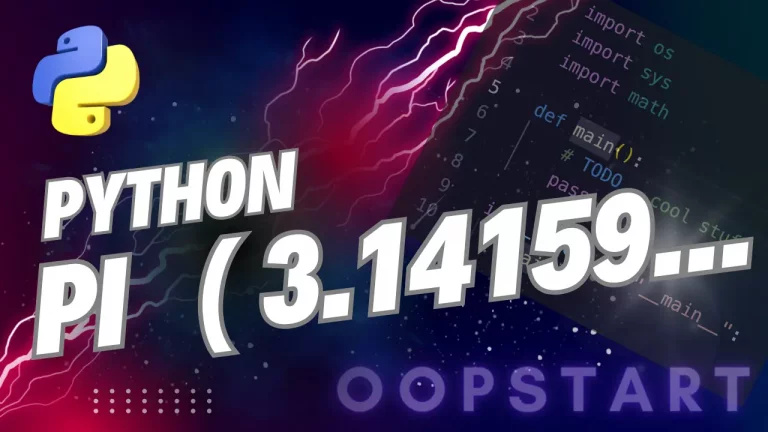List to String Python: Comprehensive Guide
In Python, lists are one of the most versatile data structures used for storing collections of items. However, there are plenty of times when you need to convert a list to a string to display the contents or prepare the data for other processes, such as file output or web transmission.
Python provides several ways to efficiently convert lists into strings, depending on the type of data and desired output format.
By the end of this guide, you’ll have a solid understanding of various list to string Python techniques suitable for your projects.
Table of Contents
Why Convert a List to a String?
Converting a list to a string is often necessary when you need to display or process data as a continuous block of text. Here are some common reasons why you might want to do this:
- Output Display: When printing or logging data, you may want to display the list in a readable format.
- Data Storage or Transmission: Converting a list to a string makes it easier to store data in files or databases, or to transmit it over networks (e.g., sending JSON data via an API).
- String Formatting: Sometimes you need to combine the elements of a list into a formatted string, such as generating a sentence or an HTML tag.
Methods to Convert a List to a String in Python
Python offers several methods for converting a list to a string, each with its own advantages depending on the use case. Below, we’ll explore some of the most common techniques.
1. Using the join() Method
The most efficient and Pythonic way to convert a list to a string is by using the join() method. This method concatenates the elements of an iterable (like a list) into a single string, with a specified separator.
Syntax:
string = separator.join(iterable)
separator: The string used to separate the elements in the resulting string.iterable: The list (or any iterable) to be joined.
Example 1: Convert a List of Strings to a Single String
fruits = ["apple", "banana", "cherry"]
result = ", ".join(fruits)
print(result) # Output: "apple, banana, cherry"
In this example, the list of fruits is converted into a single string, with each item separated by a comma and a space.
Example 2: Convert a List of Characters to a String
letters = ['H', 'e', 'l', 'l', 'o']
result = "".join(letters)
print(result) # Output: "Hello"
Here, the list of characters is joined without a separator, resulting in the word "Hello".
2. Using a for Loop
You can also convert a list to a string using a for loop to manually concatenate the elements. This approach is less efficient than using join(), but it allows for more flexibility if additional logic is needed for each element.
Example: Using a for Loop to Concatenate List Elements
numbers = [1, 2, 3, 4]
result = ""
for num in numbers:
result += str(num) + " "
print(result.strip()) # Output: "1 2 3 4"
In this example, each element is converted to a string and concatenated to the result string. The strip() method removes the trailing space at the end.
3. List Comprehension with join()
A more concise way to convert a list to a string, especially when dealing with non-string elements, is to combine list comprehension with join(). This approach is useful when you need to convert elements to strings before joining them.
Example: Converting a List of Integers to a String
numbers = [1, 2, 3, 4]
result = " ".join([str(num) for num in numbers])
print(result) # Output: "1 2 3 4"
In this case, the list comprehension [str(num) for num in numbers] ensures that all integers are converted to strings before being joined with a space separator.
4. Using the map() Function
You can also use the map() function to apply the str() function to each element in the list and then use join() to concatenate the results.
Example: Using map() to Convert a List to a String
numbers = [10, 20, 30, 40]
result = ", ".join(map(str, numbers))
print(result) # Output: "10, 20, 30, 40"
The map() function applies str() to each element of the list, converting them to strings before joining them with a comma separator.
5. Converting Nested Lists to Strings
When dealing with nested lists (lists containing other lists), converting them to a string requires flattening the list or converting each sublist separately.
Example: Handling Nested Lists
nested_list = [["Python", "is"], ["fun", "and"], ["powerful"]]
result = " | ".join([" ".join(sublist) for sublist in nested_list])
print(result) # Output: "Python is | fun and | powerful"
In this example, each sublist is first joined into a string, and then the resulting strings are joined using " | " as the separator.
Handling Lists with Mixed Data Types
Python lists can contain elements of various data types, including integers, floats, and even other lists. When converting such lists to strings, you need to ensure that non-string elements are properly converted before joining.
Example: Converting a List with Mixed Data Types
mixed_list = ["The answer is", 42, "and pi is", 3.14]
result = " ".join([str(item) for item in mixed_list])
print(result) # Output: "The answer is 42 and pi is 3.14"
In this example, both the integer (42) and the float (3.14) are converted to strings using str() before being joined with spaces.
Converting a List of Strings with Special Characters
If the list contains special characters, you can still use join(). Special characters will be treated as part of the string and will be included in the final result.
Example: Handling Special Characters
words = ["Python", "is", "fun!"]
result = " ".join(words)
print(result) # Output: "Python is fun!"
In this case, the exclamation mark in "fun!" remains part of the string after conversion.
Common Pitfalls and How to Avoid Them
1. Non-String Elements in the List
When using join(), all elements in the list must be strings. If the list contains non-string elements (such as integers or floats), you will get a TypeError.
Solution:
Convert non-string elements to strings before joining, using either map() or list comprehension.
2. Empty Lists
If the list is empty, join() will return an empty string. This is the desired behavior in most cases, but you should check for empty lists if necessary.
Example:
empty_list = []
result = " ".join(empty_list)
print(result) # Output: ""
Best Practices for Converting a List to a String in Python
- Use
join()for Efficiency: Thejoin()method is the most efficient way to convert a list to a string, especially for large lists. It is optimized for handling string concatenation in Python. - Handle Mixed Data Types: If your list contains non-string elements, always convert them to strings using
str(). List comprehension ormap()can help with this. - Check for Empty Lists: If there’s a possibility of encountering an empty list, handle it explicitly to avoid unexpected results.
- Be Mindful of Nested Lists: When working with nested lists, you’ll need to flatten the structure or join sublists separately.
Summary of Key Concepts
- The
join()method is the most efficient way to convert a list to a string in Python. - You can use list comprehension or
map()to handle lists with mixed data types (e.g., integers, floats). - Nested lists require additional handling, either by flattening or by joining sublists individually.
- Be cautious of non-string elements in the list, and ensure they are converted to strings before joining.
Exercises
- Basic List to String Conversion: Write a Python function that takes a list of words and joins them into a single string with spaces between each word.
- Mixed Data Types: Write a program that converts a list with mixed data types (e.g., integers, floats, and strings) into a formatted string.
- Nested Lists: Implement a function that takes a nested list of strings and returns a single string where each sublist is joined separately and then combined with a separator.
Check out our FREE Learn Python Programming Masterclass to hone your skills or learn from scratch.
The course covers everything from first principles to Graphical User Interfaces and Machine Learning
You can browse the official Python documentation on lists here.
FAQ
Q1: Can I convert a list of integers to a string without using join()?
A1: Yes, you can use a for loop or list comprehension to manually concatenate the integers into a string. However, using join() is the most efficient and Pythonic method. Here’s an example of using a for loop:
Example:
numbers = [1, 2, 3, 4]
result = ""
for num in numbers:
result += str(num) + " "
print(result.strip()) # Output: "1 2 3 4"
While this works, join() is usually faster and cleaner, especially for larger lists.
Q2: How do I convert a list with None values to a string?
A2: You can handle None values by converting them to a string using str() or filtering them out before joining the list elements. If you want to include None as "None" in the final string, you can convert it to a string like any other element. If you want to exclude None, use list comprehension or a filter.
Example (including None):
data = [1, None, 3, "text"]
result = " ".join([str(item) for item in data])
print(result) # Output: "1 None 3 text"
Example (excluding None):
data = [1, None, 3, "text"]
result = " ".join([str(item) for item in data if item is not None])
print(result) # Output: "1 3 text"
Q3: How can I add quotation marks around each list element when converting to a string?
A3: To add quotation marks around each element when converting a list to a string, you can use list comprehension or map() to format each element before joining them.
Example:
words = ["apple", "banana", "cherry"]
result = ", ".join([f'"{word}"' for word in words])
print(result) # Output: '"apple", "banana", "cherry"'
Q4: Can I convert a list to a string where each element is on a new line?
A4: Yes, you can use \n as the separator in the join() method to place each element on a new line.
Example:
lines = ["Line 1", "Line 2", "Line 3"]
result = "\n".join(lines)
print(result)
Output:
Line 1
Line 2
Line 3
Q5: What should I do if my list contains dictionaries, and I want to convert them to a string?
A5: If your list contains dictionaries or other complex data types, you’ll need to convert each dictionary to a string before joining. You can use the str() function or json.dumps() for more readable output if you are working with JSON-like data.
Example using str():
data = [{"name": "Alice"}, {"name": "Bob"}]
result = ", ".join([str(item) for item in data])
print(result) # Output: "{'name': 'Alice'}, {'name': 'Bob'}"
Example using json.dumps() for better formatting:
import json
data = [{"name": "Alice"}, {"name": "Bob"}]
result = ", ".join([json.dumps(item) for item in data])
print(result) # Output: '{"name": "Alice"}, {"name": "Bob"}'
Q6: What happens if I try to use join() on a list that contains non-string elements without converting them first?
A6: If you try to use join() on a list that contains non-string elements (e.g., integers or floats), Python will raise a TypeError because join() requires all elements to be strings.
Example (raises an error):
numbers = [1, 2, 3]
result = ", ".join(numbers) # TypeError: sequence item 0: expected str instance, int found
To avoid this, ensure all elements are converted to strings using map() or list comprehension.
Example (corrected):
numbers = [1, 2, 3]
result = ", ".join(map(str, numbers))
print(result) # Output: "1, 2, 3"
Q7: Can I convert a list of booleans to a string?
A7: Yes, you can convert a list of booleans to a string in the same way you would convert integers or other data types. Use str() to convert each boolean value to its string representation.
Example:
bool_list = [True, False, True]
result = ", ".join(map(str, bool_list))
print(result) # Output: "True, False, True"
Q8: Is join() faster than using a for loop for concatenating list elements?
A8: Yes, join() is significantly faster and more efficient than using a for loop for concatenating strings. The reason is that join() is optimized for handling string concatenation in a single pass, while a for loop creates new string objects in each iteration, which leads to slower performance, especially for large lists.
Performance Comparison:
import time
large_list = ["word"] * 1000000
# Using join()
start = time.time()
result = " ".join(large_list)
end = time.time()
print(f"Time with join(): {end - start} seconds")
# Using for loop
start = time.time()
result = ""
for word in large_list:
result += word + " "
end = time.time()
print(f"Time with for loop: {end - start} seconds")
Q9: Can I convert a list of lists (nested list) to a string?
A9: Yes, but you need to handle the nested structure carefully. You can either flatten the list or join each sublist separately before combining the results.
Example (converting each sublist separately):
nested_list = [[1, 2], [3, 4], [5, 6]]
result = "; ".join([", ".join(map(str, sublist)) for sublist in nested_list])
print(result) # Output: "1, 2; 3, 4; 5, 6"
Q10: Can I include custom formatting when converting a list to a string?
A10: Yes, you can apply custom formatting to each element before joining them. Use list comprehension or map() to apply the desired format to each element before concatenating them.
Example with custom formatting:
numbers = [1, 2, 3]
result = ", ".join([f"Number: {num}" for num in numbers])
print(result) # Output: "Number: 1, Number: 2, Number: 3"








